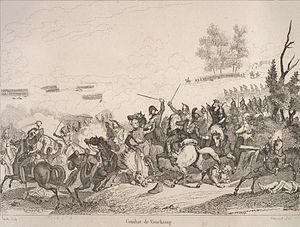Battle of Vauchamps
| Battle of Vauchamps | |||||||
|---|---|---|---|---|---|---|---|
| Part of the War of the Sixth Coalition | |||||||
 |
|||||||
|
|||||||
| Belligerents | |||||||
|
|
|
||||||
| Commanders and leaders | |||||||
|
|
|
||||||
| Units involved | |||||||
|
|
|
||||||
| Strength | |||||||
| 10,000 | 21,500 | ||||||
| Casualties and losses | |||||||
| 600 men | 9,000 men 15 artillery pieces 10 flags |
||||||
The Battle of Vauchamps (14 February 1814) was the final major engagement of the Six Days Campaign of the War of the Sixth Coalition. It resulted in a part of the Grande Armée under Napoleon I defeating a superior Prussian and Russian force of the Army of Silesia under Field-marshal Gebhard Leberecht von Blücher.
At the beginning of 1814, the armies of the French Empire, under the direct command of Emperor Napoleon I, were scrambling to defend Eastern France against the invading Coalition Armies. Despite fighting against vastly superior forces, Napoleon managed to score a few significant victories and, between 10 and 13 February repeatedly beat Blücher’s Army of Silesia. On 13 February, reeling from his successive defeats, Blücher looked to disengage from Napoleon and instead manoeuvre with a part of his forces to fall upon the isolated VI Corps of Marshal Auguste de Marmont, who was defending Napoleon’s rear. The Prussian commander attacked and pushed back Marmont late on 13 February. Nevertheless, the Emperor had read into his enemy’s intentions and directed powerful forces to support Marmont.
On the morning of 14 February, Blücher, commanding a Prussian Corps and elements of two Russian Corps, resumed his attack against Marmont. The latter continued to fall back until he was reinforced. Napoleon arrived on the battlefield with strong combined-arms forces, which allowed the French to launch a determined counterattack and drive back the leading elements of the Army of Silesia. Blücher realized that he was facing the Emperor in person and decided to pull back and avoid another battle against Napoleon. In practice, Blücher's attempt to disengage proved extremely difficult to execute, as the Coalition force was by now in an advanced position, had virtually no cavalry present to cover its retreat and was facing an enemy who was ready to commit its numerous cavalry.
While the actual pitched battle was short, the French infantry, under Marshal Marmont, and most of all the cavalry, under General Emmanuel de Grouchy, launched a relentless pursuit that rode down the enemy. Retreating in slow-moving square formations in broad daylight and along some excellent cavalry terrain, the Coalition forces suffered very heavy losses, with several squares broken by the French cavalry. At nightfall, combat ceased and Blücher opted for an exhausting night march in order to take his remaining forces to safety.
...
Wikipedia
